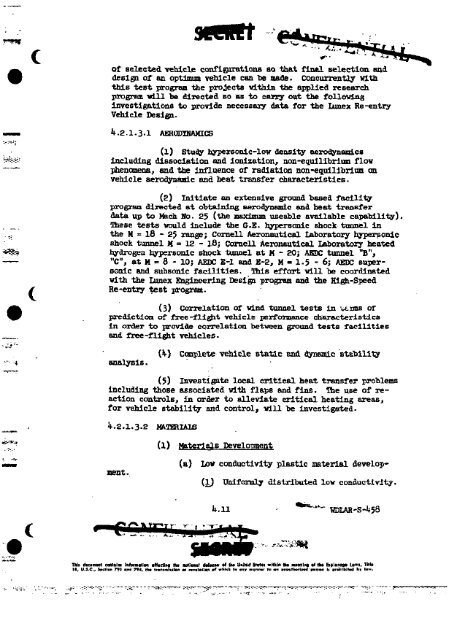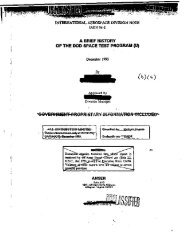LUNAR EXPEDITION PLAN
LUNAR EXPEDITION PLAN
LUNAR EXPEDITION PLAN
Create successful ePaper yourself
Turn your PDF publications into a flip-book with our unique Google optimized e-Paper software.
of selected vehicle configurations so that final selection and<br />
design of an optimum vehicle can be made. Concurrently with<br />
this test program the projects within the applied research<br />
program will be directed so as to carry out the following<br />
investigations to provide necessary data for the Lunex Re-entry<br />
Vehicle Design.<br />
4.2.1.3.1 AERODYNAMICS<br />
(1) Study hypersonic-low density aerodynamics<br />
including dissociation and ionization, non-equilibrium flow<br />
phenomena.; and the influence of radiation non-equilibrium on<br />
vehicle aerodynamic and heat transfer characteristics.<br />
(2) Initiate an extensive ground based facility<br />
program directed at obtaining aerodynamic and heat transfer<br />
data up to Mach Ho- 25 (the maximum useable available capability).<br />
ttiese tests would Include the G.E. hypersonic shock tunnel in<br />
the M = 18 - 25 range; Cornell Aeronautical Laboratory hypersonic<br />
shock tunnel If = 12 - 18; Cornell Aeronautical Laboratory heated<br />
hydrogen hypersonic shock tunnel at M - 20; AEDC tunnel "B",<br />
"C", at M = 8 - 10; AEDC E-l and E-2, M = 1-5 - 6; AEDC supersonic<br />
and subsonic facilities. Ibis effort will be coordinated<br />
with the Lunex Engineering Design program and the High-Speed<br />
Re-entry test program-<br />
(3) Correlation of wind tunnel tests in ve-uns of<br />
prediction of free-flight vehicle performance characteristics<br />
in order to provide correlation between ground tests facilities<br />
and free-flight vehicles-<br />
analysis.<br />
(k) Complete vehicle static and dynamic stability<br />
(5) Investigate local critical heat transfer problems<br />
Including those associated witli flaps and fins. The use of reaction<br />
controls, in order to alleviate critical heating areas,<br />
for vehicle stability and control, will be investigated-<br />
4.2.1.3-2 M&IERIALS<br />
ment.<br />
(1) Materials Develoratent<br />
(a) Low conductivity plastic material develop<br />
(1) Uniformly distributed low conductivity.<br />
4.11 —***»-. •WttAB-s-458<br />
TMi riKvnanl CMlaim tofomtfiofl offorflfta ttH utfeMt dabtu* •* Nw U-.Md Stut*. within ihm mMnlm tf fh* Eipianm Lewi, Tftte<br />
IB, U.ltC, SadlBfl 793 and 7*4, lh* frvniAiMloii *f mvvlalitHi *? wfcfch H *ny *onn*r tfi «n •POufKorirta' pmwtmn it #r*hlblfsd by law.




